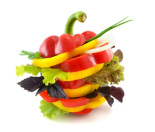 This year I discovered wild foods right in my backyard. For years I’ve been pulling out these “weeds” and then I discovered that they are truly amazing little nutritional gems. That’s right, the research is showing that wild foods can be more nutritious than a lot of veggies that we buy at the grocery store.
This year I discovered wild foods right in my backyard. For years I’ve been pulling out these “weeds” and then I discovered that they are truly amazing little nutritional gems. That’s right, the research is showing that wild foods can be more nutritious than a lot of veggies that we buy at the grocery store.
Now I am protecting my “weeds” from being eradicated from my yard. My spouse now knows not to touch the purslane, dandelions, lambs quarters, mallow or plantains growing in the yard. I go out with a basket to collect my bounty of these special weeds every couple of days along with cucumbers and tomatoes from the garden. I value these greens even more than the veggies we are growing because wild foods have so much more nutrition in them.
For example, in 100 grams I found that purslane has 383 mg of Omega 3’s.(1) That is a good amount of natural plant Omega 3’s. Why go through the fish to get the benefits of the algae that the fish eats? Just eat the algae and bypass all of the toxins that the fish contains in their tissues.
Compare the calcium in 100 grams of cows whole milk 118 mg. to the wild edible lambs quarters 309 mg. (2) Why go through the cow to get your calcium? I get my calcium from my backyard with wild lambs quarters that grow abundantly.
I could go on but I will just leave you with one more example. We all know that carrots are a great place to get your Vitamin A. Well, I looked it up and found that 100 grams of carrots will give you 11,000 IU of vitamin A. Dandelion will give you 14,000 IU of vitamin A per 100 grams.(3) You won’t see me out in the yard spraying these super nutritious greens. You will find me thankfully gathering up these amazing greens and adding them to salads and smoothies.
It is my hope to inspire people to find their own healthy, nutritious foods, including wild edibles, that do not require a large budget, or a need to go through animals to get the nutrients that they consume. I believe this is a much healthier way to eat and is much more sustainable for a earth population of over seven billion people.
Rhonda
*(1) “Edible Wild Plants Detailed Analysis of 15 Plants” by John Kallas, Ph.D2008 (2) “Edible Wild Plants” by Thomas S. Elias & Peter A. Dykeman 1982 P 273(3) “Edible Wild Plants” by Thomas S. Elias & Peter A. Dykeman 1982 p 274


